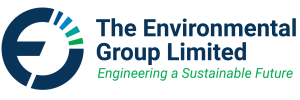A way to remove PFAS from our water
March 2024
PFAS, PFOS, PFOA Separation
On the search for a viable method for removing PFAS from our water
PFAS is per-and polyfluoroalkyl substances that are a group of chemicals used to make fluoropolymer coatings and products that resist heat, oil, stains, grease, and water. Fluoropolymer coatings can be in a variety of products. These include clothing, furniture, adhesives, food packaging, heat-resistant non-stick cooking surfaces, and the insulation of electrical wire. Many PFAS, including perfluorooctane sulfonic acid (PFOS) and perfluorooctanoic acid (PFOA), are a concern because they:
- do not break down in the environment,
- can move through soils and contaminate drinking water sources,
- build up (bioaccumulate) in fish and wildlife.
PFAS are found in rivers and lakes and in many types of animals on land and in the water.

BACKGROUND
As PFAS poses a growing environmental threat, The Environmental Group is committed to addressing this challenge while also recognising the significance of expanding into the water sector. Through careful analysis, we have identified a specialised market where we can apply our technical proficiency. After evaluating various technologies and cost considerations, we have partnered with Victoria University, aligning with our shared goals and their expertise.
CHALLENGE
Navigating through a phased approach and conducting rigorous testing with our research partner, we transitioned from desktop simulations to piloting and eventually to a commercial plant scale. This enabled us to showcase our technology in a controlled environment and successfully scale up while addressing various PFAS waste streams. Throughout this process, we encountered no significant challenges, thanks to our methodical approach.
OBJECTIVE
Our primary objective is to develop a unique and commercially viable method for removing PFAS from water, thus offering a cost-effective solution for environmental improvement. We aim to create a system that requires minimal human intervention and eliminates manual handling, while also avoiding the generation of additional waste streams such as filter media. Scalability in volume and mobility are key considerations in the development of this system.
SOLUTION
Foam fractionation, employing our specifically designed charged gas, stands as a pivotal separation technique utilised across industries to extract and concentrate substances from liquid solutions. This innovative approach involves the introduction of a custom charge gas into the solution, which enhances the process’s selectivity and efficiency
IMPLEMENTATION
- Desktop Research and Trials at Victoria University (VU): In the initial stages, thorough desktop research and trials were conducted at Victoria University to validate the scientific principles and feasibility of our technology. These foundational studies provided essential insights and formed the basis for further development.
- Pilot Testing: Following successful desktop research, pilot testing was initiated to scale up the technology and assess its performance under real-world conditions. This phase involved conducting controlled experiments to fine-tune the process parameters and validate the effectiveness of our solution on a larger scale.
- Pilot Testing at an EPA Licensed Treatment Facility: To further validate the technology’s efficacy and compliance with regulatory standards, pilot testing was conducted at an EPA licensed treatment facility. This step ensured that our solution met all necessary environmental and safety regulations, paving the way for broader acceptance and deployment.
- Commercial Plant Integration: With proven success in pilot testing, the technology was integrated into a commercial plant, seamlessly integrated into a liquid treatment facility for full-scale commercial operation. This integration marked a significant milestone, demonstrating the readiness of our solution for widespread implementation and commercialization.
RESULTS
Through these progressive stages of development, from desktop research to commercial integration, our technology has undergone rigorous testing and validation, positioning it as a reliable and effective solution for addressing environmental challenges.
Our PFAS Separation technology has demonstrated outstanding results in commercial trial, successfully separating and removing PFAS from liquid waste streams by over 99%.
Consistent results demonstrated with regulated PFAS separated and removed to levels below detection limits in all high-volume low concentrate trials which represents a significant portion of the market.
At the highest concentrate trials (c. 40ppb total PFAS) regulated PFAS was removed over 99.4% on the first processing run with trials ongoing on these higher concentrated PFAS waste streams.
Our newly developed PFAS Separation technology has considerable advantages against other PFAS removal technologies including being simpler, safer, more versatile and more cost effective.
CONCLUSION
- Diverse Waste Stream Management: Unlike traditional methods that may struggle with various waste streams, our approach efficiently handles diverse waste compositions. This versatility minimizes the need for additional treatments and ensures comprehensive pollutant removal.
- Preservation of Soil Organic Components: By avoiding thermal treatment, which can destroy organic components in soil, our method maintains the integrity of soil ecosystems. This aspect is crucial for preserving soil health and biodiversity, contributing to sustainable environmental practices.
- Reduced Environmental Impact: Our process eliminates the need for transporting contaminated materials to off-site treatment facilities, significantly reducing the risk of environmental disasters or accidents during transportation. This minimizes associated costs and potential environmental harm.
- Smaller Carbon Footprint: Compared to traditional methods that often involve energy-intensive processes, our approach boasts a smaller carbon footprint. By prioritizing efficiency and minimizing energy consumption, we contribute to environmental sustainability and climate mitigation efforts.
- Safe and User-Friendly Operation: Our method offers a streamlined three-step process, ensuring simplicity and ease of operation compared to technologies with lengthier and more complex procedures. This simplicity enhances safety and reduces the likelihood of operational errors or accidents.
In summary, our PFAS removal solution not only provides a cost-effective alternative to traditional absorption technologies but also offers superior environmental benefits, including efficient waste stream management, preservation of soil integrity, reduced environmental impact, minimized carbon footprint, and safe, user-friendly operation. These advantages position our method as a standout choice for addressing PFAS contamination while prioritizing environmental stewardship and sustainability.
